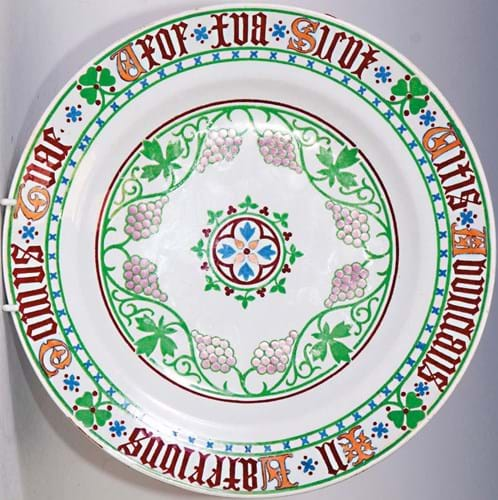Only three pieces from the service are thought to be in private hands.
Pugin had first turned to Herbert Minton (1793-1858) the most progressive ceramic manufacturer of the early Victorian period, to make ‘encaustic’ tiles for his medieval-revival churches.
The two men soon collaborated on a range of gothic style domestic wares.
Perhaps the best known of these is the Waste Not Want Not bread plate described as shape number 430 and ‘Pugin’s Bread Tray – Encaustic’ in the Minton archive. It was first shown by Minton & Co at an exhibition held in Birmingham in 1849 by the British Association for the Advancement of Science and subsequently made in a number of different glaze treatments
The Minton and Hollins ‘New Stone’ wares offered at Bamfords in Rowsley on June 19-20 are from a service commissioned by Pugin for use at his family home, The Grange, in Ramsgate. It was made c.1851 using the technique of multicolour ‘block’ printing on ceramics that had been patented in 1848. Both Pugin and Minton were quick to see the advantages of the new process. As it allowed the printing of solid areas of colour it was particularly suited to the complex flat pattern designs that were such a strong component of Pugin’s Gothic style.
Similar plates were on sale at Pugin’s Medieval Court at the Great Exhibition, including examples now owned by the Victoria & Albert Museum.
Numbering close to 200 pieces, the Pugin service was rediscovered in 1983 by Reverend Anthony Fagan in the Priest’s House, St Mary’s Roman Catholic Church in East Hendred, Oxfordshire where it had seemingly been left by the Pugin family for safekeeping. Saving on commission fees, Father Fagan personally negotiated its sale to the Palace of Westminster and in gratitude was gifted three pieces.
After his recent death two of these were sent for sale by a relative in the Greater Manchester area in the hope of covering funeral costs. They were estimated at £600-1000 each.
A 10½in (26cm) octofoil shallow dish with a central Gothic P within a clover leaf roundel is of the same design as a footed comfort pictured on the UK Parliament website. It brought £5000 (plus 24.5% buyer’s premium) from a UK private buyer.
A circular plate with a central Gothic roundel surrounded by scrolling vines has a Latin inscription relating to abundance in the home. The grapes and the capital letters are picked out in overglaze enamels. More akin to the plates sold at Pugin’s Medieval Court in 1851, it went to what the auctioneers called “a well-established London buyer” at £5300.
The Houses of Parliament was understood to be among the underbidders of both pieces.
















